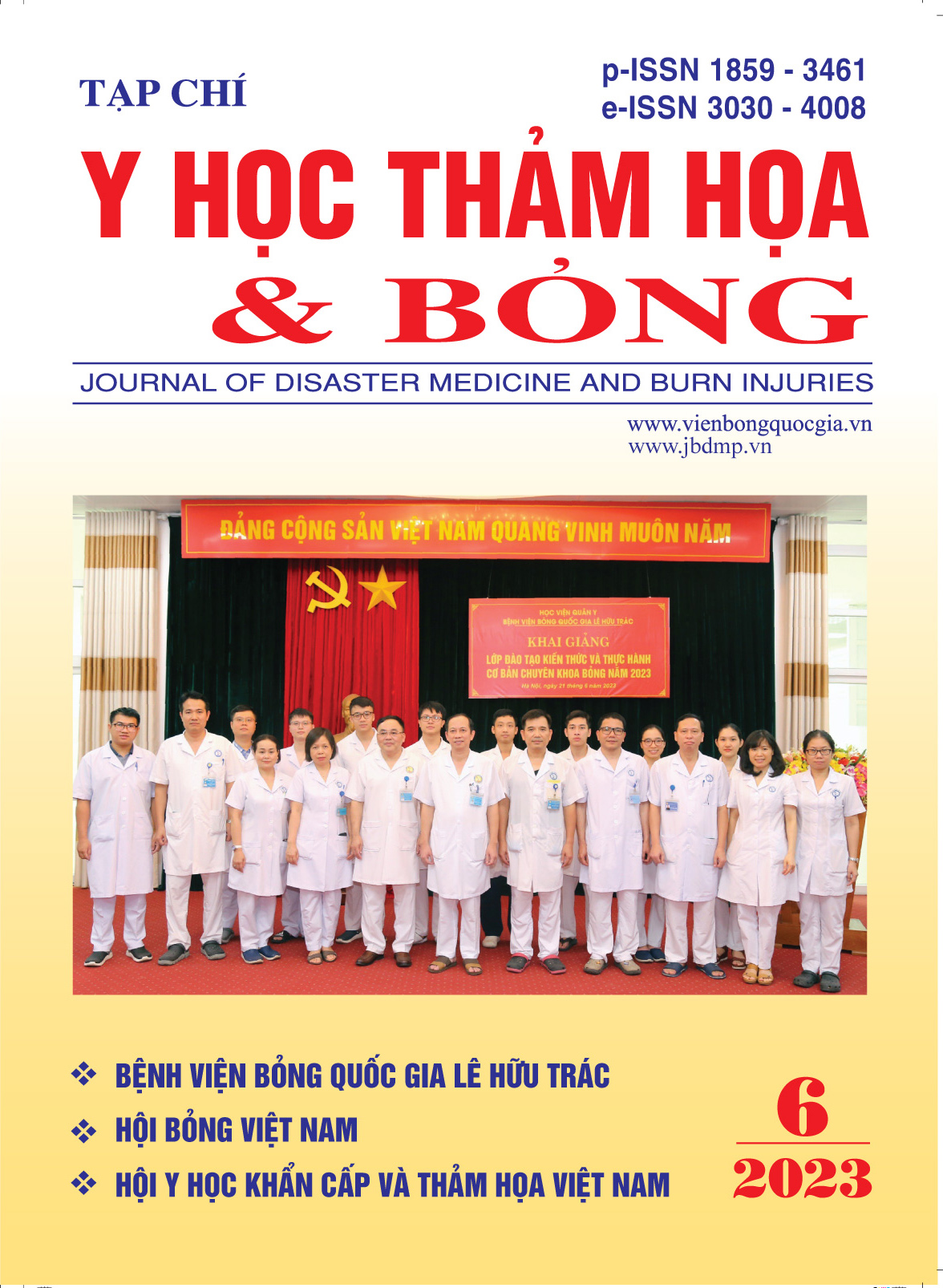CHARACTERISTICS AND FACTORS AFFECTING THE OUTCOMES OF MASSIVE BURN PAEDIATRIC PATIENTS
Main Article Content
Abstract
This study investigated characteristics and factors affecting the outcome of massive burn in children. A retrospective study was conducted on 288 paediatric burn patients (=<16 years old) with burn extent ≥ 30% of total burn surface area (TBSA) admitted to the National Burns Hospital from 1/1/2018 to 31/12/ 2022. Patients were divided into two groups of survival and death comparing demographic characteristics, burn features and outcome. The results showed that most patients were under 6 years old (79.51%), boys (64.58%), due to scald (76.69%). Inhalation injury accounted for 6.25% and overall mortality rate was 6.94%. There was no remarkably difference between survival and death groups in terms of age, gender and admission time (p > 0.05). Meanwhile, death group had significantly greater burn extent, deep burn area as well as rate of inhalation injury than the survival group (p < 0.01). The most fatal causal agent was flame as compared to scald and other agents (18.75%; p < 0.01). Multivariate analysis showed that the increased deep burn area and the presence of inhalation injury were independently risk factors for mortality with AUC = 0.82; sensitivity: 80%; specificity: 91.42% in case of combining both variates.
Article Details
Keywords
Massive burns, pediatric, outcomes
References
2. Kurmis R., Nicholls C., Singer Y., et al. (2022), An investigation of early enteral nutrition provision in major burn patients in Australia and New Zealand. Nutrition & Dietetics, 79 (5), 582-589.
3. Cheng W., Shen C., Zhao D., et al. (2019), The epidemiology and prognosis of patients with massive burns: A multicenter study of 2483 cases. Burns, 45 (3), 705-716.
4. Sheridan R. L., Hinson M. I., Liang M. H., et al. (2000), Long-term outcome of children surviving massive burns. Jama, 283 (1), 69-73.
5. Martens S., Romanowksi K., Palmieri T., et al. (2023), Massive Pediatric Burn Injury: A 10-Year Review. Journal of Burn Care & Research, 44 (3), 670-674.
6. Lee C. J., Mahendraraj K., Houng A., et al. (2016), Pediatric burns: a single institution retrospective review of incidence, etiology, and outcomes in 2273 burn patients (1995–2013). Journal of Burn Care & Research, 37 (6), e579-e585.
7. Kobayashi K., Ikeda H., Higuchi R., et al. (2005), Epidemiological and outcome characteristics of major burns in Tokyo. Burns, 31 (1), S3-S11.
8. Lo C. H., Chong E., Akbarzadeh S., et al. (2019), A systematic review: current trends and take rates of cultured epithelial autografts in the treatment of patients with burn injuries. Wound Repair and Regeneration, 27 (6), 693-701.
9. Dolp R., Rehou S., McCann M. R., et al. (2018), Contributors to the length-of-stay trajectory in burn-injured patients. Burns, 44 (8), 2011-2017.
10. Kraft R., Herndon D. N., Al-Mousawi A. M., et al. (2012), Burn size and survival probability in paediatric patients in modern burn care: a prospective observational cohort study. The Lancet, 379 (9820), 1013-1021.
11. Karimi H., Motevalian S. A., Momeni M., et al. (2015), Etiology, outcome and mortality risk factors in children burn. Surgical Science, 6 (02), 42.
12. Chalya P. L., Mabula J. B., Dass R. M., et al. (2011), Pattern of childhood burn injuries and their management outcome at Bugando Medical Centre in Northwestern Tanzania. BMC research notes, 4, 1-10.


